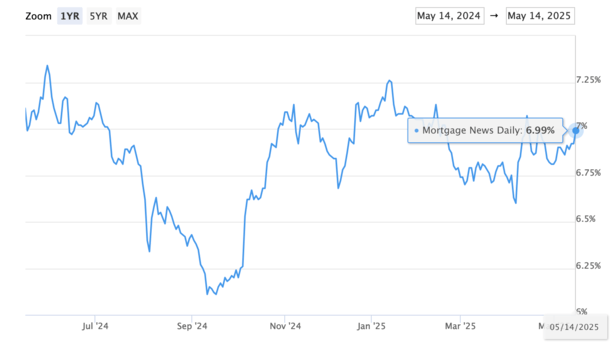Today we’ll take a look at the top mortgage lenders in Texas based on their annual production last year, including both retail and wholesale loan volume.They say everything is bigger in Texas, and that’s true when it comes to their mortgage lending volume relative to 49 other states.Only California is bigger when the subject is doling out home loans. And they even double New York’s output.The Lone Star State accounted for about nine percent of national home loan volume, originating roughly $147 billion in 2024.Let’s find out who the top lenders were in the state in a few different categories.Top Mortgage Lenders in Texas (Overall)RankingCompany Name2024 Loan Volume1.UWM$12.6 billion2.Rocket Mortgage$7.0 billion3.DHI Mortgage$5.7 billion4.Chase$3.9 billion5.Lennar Mortgage$3.7 billion6.CMG Mortgage$3.3 billion7.loanDepot$2.7 billion8.Fairway Independent$2.6 billion9.PrimeLending$2.4 billion10.CrossCountry$2.2 billionYep, United Wholesale Mortgage (UWM) did it again, topping the overall rankings in Texas with $12.6 billion in home loan volume in 2024, per HMDA data from Richey May.They were also number one overall, and in the states of California and Florida, so it’s no surprise they took Texas too.The Pontiac, Michigan-based lender led the way in many states nationwide so this came as no real surprise.Coming in second was former #1 Rocket Mortgage with a much smaller tally, just $7.0 billion funded.In third was DHI Mortgage, which is the in-house lender for D.R. Horton. This is interesting because builders have never been top mortgage lenders until recently.Basically, their ability to offer massive mortgage rate buydowns makes them near-impossible to compete with.JP Morgan Chase was fourth with $3.9 billion, representing the strongest showing for a depository bank.I say that because nonbank mortgage lenders are all the rage these days, with brick-and-mortar banks often taking a back seat.In fifth was another home builder’s mortgage lender, Lennar Mortgage, with $3.7 billion funded. Pretty uncommon to see two builders make the top-10.But it’s a sign of the times, especially in Texas where new construction homes are abundant.Others in the top-10 included CMG Mortgage, loanDepot, Fairway Independent Mortgage, PrimeLending, and CrossCountry Mortgage.Top Mortgage Lenders in Texas (for Home Purchases)RankingCompany Name2024 Loan Volume1.UWM$9.1 billion2.DHI Mortgage$5.7 billion3.Rocket Mortgage$4.1 billion4.Lennar Mortgage$3.7 billion5.Chase$3.2 billion6.CMG Mortgage$3.0 billion7.Fairway Independent$2.4 billion8.loanDepot$2.3 billion9.PrimeLending$2.2 billion10.CrossCountry$1.9 billionNow let’s turn our attention to home purchase lending, which grabbed an 83% market share last year in Texas as refinances dropped off due to higher mortgage rates.Purchase loans quickly became the focus for pretty much all mortgage lenders once rates began to rise from their record lows in 2022.Simply put, 6%+ mortgage rates mean it’s a lot more difficult to drum up refinance business. Thus, lenders are concentrating on home buyers.In 2024, lenders in Texas had about an 83%/17% purchase to refi share, which is quite massive.UWM held the top spot last year with $9.1 billion in home purchase loans in the state, beating out D.R. Horton’s in-house lender.Rocket lost out to one builder, but beat another, Lennar Mortgage, and Chase came in fifth.bank Wells Fargo with $6.6 billion.Not far behind was CMG Mortgage, followed by Fairway Independent Mortgage, loanDepot, PrimeLending, and CrossCountry.The list featured the same exact lenders as the top overall (in slightly different order), which is no surprise given purchase lending dominated last year.Top Mortgage Lenders in Texas (for Mortgage Refinances)RankingCompany Name2024 Loan Volume1.UWM$3.5 billion2.Rocket Mortgage$2.7 billion3.Pennymac$625 million4.Freedom Mortgage$615 million5.Chase$558 million6.Mr. Cooper$470 million7.loanDepot$414 million8.Village Capital$384 million9.Newrez$349 million10.Randolph Brooks$307 millionFinally, we’ve got mortgage refinances, which are reserved for existing homeowners.Borrowers take out these types of loans for either a lower rate (rate and term refinance) or to tap equity (cash out refinance).UWM was again #1, no real surprise, followed by Rocket Mortgage, also not a surprise. Though usually Rocket comes in first here.Nobody else was even close, with third place Pennymac only able to muster $625 million and Freedom Mortgage doing a similar $615 million.It then dropped off even more with Chase, loan servicer Mr. Cooper (soon to be owned by Rocket), loanDepot the next in line.Others in the top-10 included Village Capital (a government streamline refi specialist), Newrez, and credit union Randolph Brooks.Top Mortgage Lenders in AustinRankingCompany Name2024 Loan Volume1.UWM$1.4 billion2.CMG Mortgage$769 million3.Rocket Mortgage$601 million4.DHI Mortgage$588 million5.Lennar Mortgage$545 million6.Chase$523 million7.ClosingMark$467 million8.First United Bank$415 million9.loanDepot$412 million10.Fairway Independent$393 millionTop Mortgage Lenders in DallasRankingCompany Name2024 Loan Volume1.UWM$3.5 billion2.Rocket Mortgage$1.8 billion3.DHI Mortgage$1.6 billion4.Chase$1.1 billion5.Lennar Mortgage$954 million6.PrimeLending$792 million7.CrossCountry$734 million8.loanDepot$721 million9.Supreme Lending$675 million10.Provident Funding$633 millionTop Mortgage Lenders in Fort WorthRankingCompany Name2024 Loan Volume1.UWM$1.2 billion2.Rocket Mortgage$749 million3.DHI Mortgage$663 million4.Service First$330 million5.Chase$326 million6.Guild Mortgage$292 million7.Fairway Independent$275 million8.CrossCountry$273 million9.loanDepot$248 million10.Supreme Lending$233 millionTop Mortgage Lenders in HoustonRankingCompany Name2024 Loan Volume1.UWM$3.5 billion2.Rocket Mortgage$1.8 billion3.DHI Mortgage$1.1 billion4.Chase$1.1 billion5.Lennar Mortgage$916 million6.loanDepot$799 million7.CMG Mortgage$774 million8.Cadence Bank$632 million9.Benchmark$469 million10.Fairway Independent$448 millionTop Mortgage Lenders in San AntonioRankingCompany Name2024 Loan Volume1.Lennar Mortgage$971 million2.UWM$904 million3.DHI Mortgage$816 million4.Rocket Mortgage$561 million5.KBHS Home Loans$340 million6.loanDepot$323 million7.Randolph Brooks$314 million8.Pulte Mortgage$296 million9.Veterans United$294 million10.Chase$256 millionGo Big or Go Home in Texas?Every time I write about the largest mortgage lenders in a certain state, I do my best to separate size from quality.Or at least point out that they are two unique things, despite “top” and “biggest” being used interchangeably.For some, top means best quality, while biggest means, well, biggest.Of course, these two things can go hand in hand, so it’s not always easy to differentiate.If you look at the lists above, only a handful of the mortgage companies mentioned are headquartered in Texas.I believe only Nationstar (Mr. Cooper), D.R. Horton’s DHI Mortgage, Benchmark, Randolph Brooks, Service First, Supreme Lending and PrimeLending are Texas-based companies.The rest are national mortgage lenders that simply do a lot of business in the state of Texas.So if you prefer a homegrown lender, you may want to look elsewhere, such as a local bank, credit union, or mortgage broker.But you might have a wonderful mortgage experience working with one of the biggest mortgage lenders in Texas too.Regardless, the important thing is to gather multiple quotes to ensure you don’t miss out on a better deal elsewhere.This is especially true in today’s mortgage market, where rates can vary widely from one lender to the next.(photo: Marcin Wichary) Before creating this site, I worked as an account executive for a wholesale mortgage lender in Los Angeles. My hands-on experience in the early 2000s inspired me to begin writing about mortgages 19 years ago to help prospective (and existing) home buyers better navigate the home loan process. Follow me on X for hot takes.Latest posts by Colin Robertson (see all)


